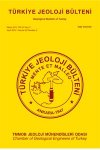
- 2025
-
2024
-
2023
-
2022
-
2021
-
2020
-
2019
-
2018
-
2017
-
2016
-
2015
-
2014
-
2013
-
2012
-
2011
-
2010
-
2009
-
2008
-
2007
-
2006
-
2005
-
2004
-
2003
-
2002
-
2001
-
2000
-
1999
-
1998
-
1997
-
1996
-
1995
-
1994
-
1993
-
1992
-
1991
-
1990
-
1989
-
1988
-
1987
-
1986
-
1985
-
1984
-
1983
-
1982
-
1981
-
1980
-
1979
-
1978
-
1977
-
1976
-
1975
-
1974
-
1973
-
1972
-
1971
-
1970
-
1969
-
1968
-
1966
-
1964
-
1963
-
1961
-
1959
-
1958
-
1955
-
1954
-
1953
-
1952
-
1951
-
1950
-
1949
-
1948
-
1947
Abstract: In this study, paleontological and biostratigraphic characteristics of the Paleogene geologic unitsoutcropping between Kuscu and Macun villages located around Temelli district, Polatli, Ankara. We haveexamined the patterns of Pelecypoda and Gastropoda samples. Seven measured stratigraphic sectionfrom the west of Macun village to east of Kuscu village, which contains the Pelecypoda and Gastropodapatterns, reach total thickness of 52 metres. As a result of field studies, seven species belongs to class ofPelecypoda and one of the new sixteen species belongs to class of Gastropoda have been described. Considering paleogeographic distribution and biostratigraphy of described fauna, it is quite proper topropose that they represent Thanetian age and can be interpreted as belonging to Kırkkavak Formation.Furthermore, the paleoecologic characteristics of the fauna strongly suggests that the shallow andtemperate coastal marine facial conditions were prevalent at the region during that time span.
Abstract: This study is aimed to perform digital geologic mapping and ASTER image analysis around southeasternpart of the Sivas Tertiary Basin. The interest area is located at the intersection of ENE-WSW orientedDeliler Thrust Belt and Tecer Fault Zone. Ophiolithic rocks which were belonging to Inner TaurideOcean Suture belt were outcropped in a vast region. This region also forms the northern boundary of theMenderes-Tauride platform. Tectonostratigraphy of the region is represented by two different sedimentarysequences separated by Deliler Fault Zone. While a thick cover of Oligocene-Miocene continental unit wasobserved on the southern section of Deliler Fault Zone, Lower-Middle Eocene marine, Oligocene gypsumand Lower Miocene marine sediments were outcropped on the northern part of this belt. Late Miocenecontinental deposits were folded while Plio-Quaternary fluvial sediments were observed horizontallyalong the Deliler Thrust Zone. Within the context of this study, interested region was mapped digitallyusing tablet pc and ArcPad software. Using this software, areas of outcropping units, linear geologic mapelements like faults and fold axes were recorded digitally during field studies and some database queriessuch as formation name, age, and lithologies were determined in terms of saving time and digitizationefforts. Additionally, a number of image processing efforts were applied to 14 channels ASTER image ofthe region to highlight geological features such as lithological boundaries and structural components.Thus, a detailed digital geologic map was formed at the end of this search. Furthermore, a number ofimage processing studies were acquired supporting geological mapping at field.
Abstract: Polymetallic mineralizations around Mayıslar Village (Sarıcakaya-Eskişehir) are located in andesiticrocks of Eocene aged Meyildere Volcanites and in ultramafic rocks of Cretaceous aged Dağküplü Melangewhich is tectonically emplaced in the region. The mineralizations are formed at different stages andcaused alterations in the host rocks. Quartz and calcite veins intersect the altered andesites which aresilicified, seriticized, argillized and enriched by tourmalines. According to macroscopic and microscopicinvestigatons, at least two quartz generations as early and late quartzs (Quartz-I and Quartz-II) andcalcite formations together with and further than late stage quartzs have been determined. Ore microscopicstudies have revealed that in addition to oxide and sulfide minerals in the host rocks, sulfide minerals suchas pyrrhotite, pyrite, chalcopyrite, galena, sphalerite, fahlore and arseopyrite are determined.Fluid inclusion studies carried out on quartzs and calcites showed that Quartz-I generation exhibit theformation temperatures of 4700 - 3700 C and salinities of 27- 41% NaCl equivalent. Late stage quartzs(Quartz-II) and accompanying calcites with some exceptions between 3700 - 2700 C, display the formationtemperatures of 2700 -1100 C and salinities under 7% NaCl equivalent. Ore minerals seem to occur withlate stage quarzs and calcites.Considering together of alteration and ore minerals, tourmalines and fluid inclusion data strengthen thepossibility of a buried granitoidic intrusion. All these data indicate the reasonable view of siliceous,carbonaceous and ore bearing solutions moved from this intrusion due to tectonic activities as differentstages altered andesites and other country rocks and caused the formation of mineralizations.

 TMMOB
TMMOB